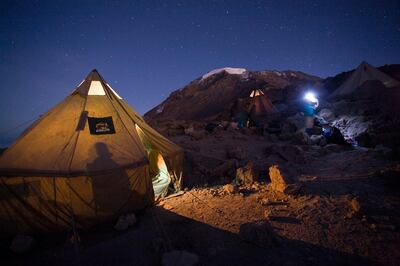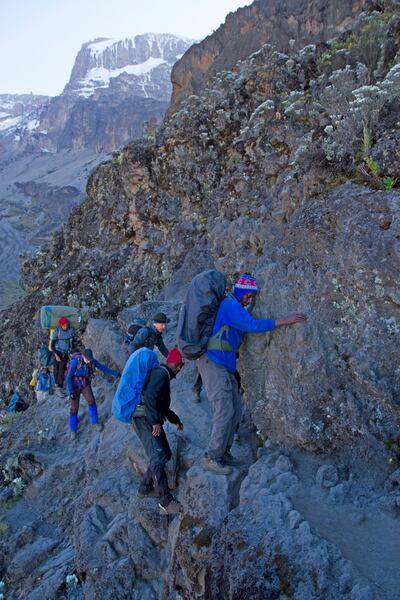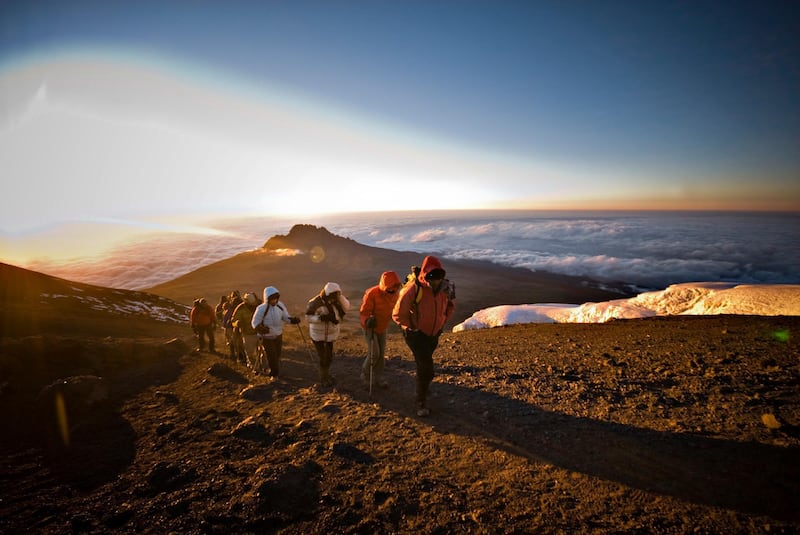When I tell friends that I'm off to Tanzania to climb Kilimanjaro, they "ooh" and "aah". Easy to see why, when Mount Kilimanjaro – literally the roof of Africa at 5,895 metres tall – boasts a superlative landscape. What makes Kili, with its extinct and dormant volcanic cones, especially popular with the globetrotting set is that you don't need to have any specific technical competence to scale her. Good physical fitness, an ability to acclimatise and great attitude are mandatory, however.
In the weeks leading up to my climb, I walk, as advised, for several hours each day, on slopes ranging between 10 and 40 degrees, on a variety of terrain. Outdoor-gear stores turn into our favourite haunts. Clothes that enable us to peel in and out of layers, like self-regulating ecosystems, become investments. A well-thumbed packing list lies by my bedside. Worn-in hiking-boots, check. Gaiters to keep small stones out of my hiking boots, check. Headlamp and spare batteries, check and check.
I also research with forensic attention to detail the route permutations that I can follow to ascend Kilimanjaro. Lemosho, which is an eight-day trek of moderate difficulty and allows sufficient time for acclimatisation while passing through striking landscapes, ends up ticking my boxes.
But while everything aims to prepare me for the mountain, nothing can entirely protect me from it. The weather in Kilimanjaro from the first day is as moody and changeable as a teenage girl. A period of cheerful sunshine is followed by a burst of angry, spitting rain. "Dress pessimistic, talk optimistic" is perhaps the best advice I receive.
I'm navigating an Afromontane forest, filigreed by endemic trees. "Pole, pole [slow, slow]," the guide calls to me, as I attempt to scoot on ahead, on what for me is still a gentle slope.
The key to the trek is to breathe in and out of your nose as you hike, to acclimatise properly to the changes in altitude. The other vital rule is to drink at least four litres of water per day. Proper hydration, willpower and successful adaptation to the thinning air are integral to the success of this journey. The walking poles, which can be rented before embarking on the climb, become my new best friend.
At my pre-designated camp each evening, time evaporates, and the playing cards I have brought aren't taken out of their case. The soundtrack as I settle into my tent (set up by the porters, who charge on ahead) is frequently that of these men singing with zesty fervour. The mountain appears to give them energy, no matter how exhausting the day.
Another essential is to eat well, but I need no encouragement. The competent chef travelling with my group whips up elaborate gourmet meals from pre-specified ingredients. At dinner each night, I submit to one of the many rituals that become staples of a well-guided mountain experience. A finger-pulse oximeter is used to check my heart rate and level of blood oxygen.
The camp wakes each day with a great sense of optimism. Sounds of people chattering can be heard from the tents as early as dawn. We generally set off around 6am, embarking on what on average ends up being about seven hours of trekking. The head guide, Bonaventure, with all the assurance of someone who has dozens of climbs under his belt, leads us forward with zeal.

The transformations of the ecosystems, as we journey up the mountain, are sudden and surprisingly defined. Here, a juniper forest. There, the Shira Plateau. The next day, a stark, alpine desert and glacial field.
I am frequently stimulated by the magic in the landscape around me, as the guide points out features that make each terrain unique. In the moorland, for instance, I feel like Gulliver must have on his travels, surrounded by giant Lobelia that grow commandingly to two metres high. Lose attention on a trail, and you stand to miss the spectacle of a unique everlasting flower, or the feeling of walking on a sprawling carpet of moss and lichen. Apart from global warming, there is nothing to disturb the peace of this fragile ecosystem but ourselves. Sadly, the dictum to take only photographs and leave only footprints is not always observed by the travelling hordes, who are frequently guilty of leaving tissue-paper trails.

During my eight days, there are many experiences that stand out. Climbing the Barranco Wall pushes physical boundaries, scrambling up rocks like a pack of apes. The sight of flowers and plants able to adapt to each varying climatic condition. But the most indelible experience is the journey to the summit.
Base camp is Barafu, which means enduring extreme conditions, at 4,673 metres above sea level. It's so hot during the day that you sweat and so cold at night that you feel close to frozen. We choose frozen, and leave Barafu at 11pm, dressed like Eskimos, buffeted by an icy wind. The isolation, chill and exhaustion as I ascend in the blue-black night is itself an experience.
The atmospheric oxygen, diminishing now to nearly half that at sea level, is the lowest it has been on the trail. The water in my bottle has frozen and I nibble on chocolate bars to keep my basic energy flowing. Sitting down at this point would be a supremely bad idea. Finally and completely drained of energy, I arrive at snowy Stella Point. The sun rises, glowing and full of hope, illuminating a vast icy landscape. Energised by the expansive awe-inducing views, I push forward on the final 45-minute ascent to Uhuru Peak, at 5,895 metres, which is my triumphant destination.

But what goes up must come down. The descent begins after an hour, via the Mweka route. As I slide down slopes of scree, even the knee-jarring downward path doesn't dampen my feeling of exhilaration. The mountain experience, on the whole, has been epic. Internal and external challenges have been conquered. Environmental issues have been comprehended. The summit is a reward. And who wouldn't want to be a part of their own fairy tale?
_______________________
Read more:
A guide to picking the perfect seat for your flight
This hotel room within a bubble takes glamping to a whole new level
Hike the ancient Bedouin lands on the Sinai trail
_______________________





